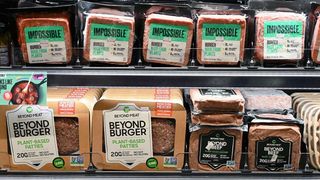Australia’s strong agricultural science has built a reputation for quality. Australian beef in particular is highly sought after around the world. Almost three quarters of the beef produced in Australia is exported, making Australia the third largest beef exporter in the world.
Australians (and Americans) eat the most meat in the world, consuming an average of more than 100kg per person each year.
Around a quarter of Americans reported eating less meat in 2019 than in previous years. Health concerns are the major driver, but the environmental impact of meat also concerns consumers.
Yet a shift is happening. Around a quarter of Americans reported eating less meat in 2019 than in previous years. Health concerns are the major driver, but the environmental impact of meat also concerns consumers.
Over a third of Americans who reduced their meat consumption indicated they were eating meat replacements such as plant-based burgers or sausages. More than 12 per cent of the Australian population are vegetarians, a population percentage that has been rising slowly and steadily since 2012.
In 2019, plant-based ‘meat’ exploded onto the American market with plant-based meat companies becoming household names. Impossible Foods has gone from being a Silicon Valley hit to raising more than US$680 million in investment from a roll-call of high-profile celebrities and powerhouse institutional investors. Beyond Meat’s successful IPO was followed by strong financial results.
Setting aside the health drivers, the environmental argument for plant-based diets is compelling. The carbon footprint of an ‘Impossible Burger’ is 89 per cent smaller than a regular beef burger, uses 87 per cent less water and 96 per cent less land.

So, is the rise of plant-based meat an opportunity or a problem for Australia?
The main ingredients of Impossible Foods and Beyond Meat burgers are soy protein, pea protein, rice protein, mung bean protein, and canola, coconut and sunflower oils. While Australian beef is a significant export product, Australia is a net importer of soy-based products.
And this is where Australia’s strong history of agricultural innovation to suit our environment coupled with the premium nature of our food products comes to the fore. For example, Victorian company Australian Pulse Proteins recently announced their new A$20 million production facility will have the ability to extract 85 to 90 per cent of the protein content from fava beans – a plant protein used to manufacture protein bars and meat substitutes. In comparison, traditional plant-based protein extraction is around 40 – 45 per cent.
But without significant venture capital investment into Australia’s agricultural technology (AgTech), the opportunity to build globally focused, world-class companies is in jeopardy. Venture capital investment in AgTech is an area where Australia lags the United States, Canada and Israel, putting at risk our opportunity to build globally focused, world-class companies.
But without significant venture capital investment into Australia’s agricultural technology (AgTech), the opportunity to build globally focused, world class companies is in jeopardy.
Australian AgTech incubator programs such as SparkLabs Cultivate and SproutX are filling the pipeline of ideas with potential, and Australia is well on its way to having its first dedicated agrifoodtech VC firm, Tenacious Ventures. However, the US$450m in Seed to Series B venture capital investment in US-located agriculture startups in 2019 far outstrips Australian investment.
The depth of capital in the United States, particularly in California, New York and Massachusetts, supports investment specialisation on a level not seen in Australia. The New York-based LeverVC, for example, is a venture capital company with a sole focus on early-stage investments in alternative protein companies.
In Australia, the CSIRO in partnership with fast-food chain Hungry Jack’s, launched v2food, a plant-based meat alternative, in late 2019 with A$35m in Series A funding. Bringing the world-class science of the CSIRO together with a strong path to market – there are around 400 Hungry Jack’s stores in Australia – and targeted investment is smart.
The global alternative protein market is expected to grow at a compound annual growth rate of 9.5 per cent from 2019 to reach US$17.9 billion by 2025. While this is small compared to the US$1.7 trillion global meat market, is it any wonder venture capitalists are looking to get in early? Savvy entrepreneurs should be looking for ways to take advantage of this emerging global trend, and Australia should encourage them every step along the way.
Alternative protein needn’t be a disruptor. Australians are good at producing beef and should continue to do so. Adding a focus on alternative protein, setting our sights early on taking advantage of our agricultural science and supporting it with significant investment to develop the products, services and supply chains will enable us to get ahead of the curve of opportunity.
Here is a case of an emerging industry where we have strong foundations and strong capabilities. We need both the entrepreneurs and the investment to make it happen.






